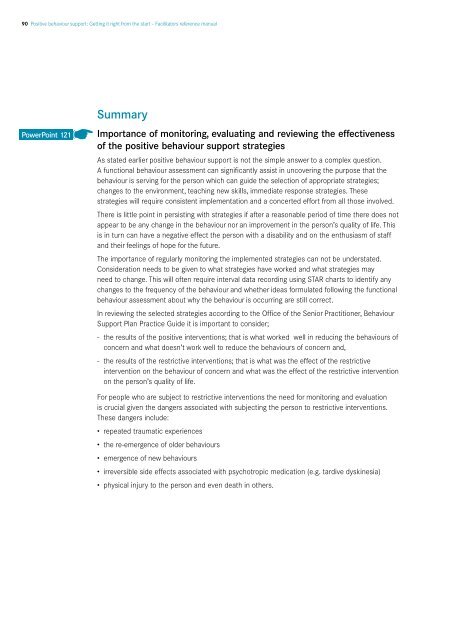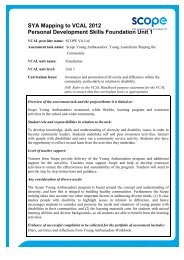Positive behaviour support Getting it right from the start
Positive behaviour support Getting it right from the start
Positive behaviour support Getting it right from the start
You also want an ePaper? Increase the reach of your titles
YUMPU automatically turns print PDFs into web optimized ePapers that Google loves.
90 <strong>Pos<strong>it</strong>ive</strong> <strong>behaviour</strong> <strong>support</strong>: <strong>Getting</strong> <strong>it</strong> <strong>right</strong> <strong>from</strong> <strong>the</strong> <strong>start</strong> - Facil<strong>it</strong>ators reference manual<br />
PowerPoint 121*<br />
Summary<br />
Importance of mon<strong>it</strong>oring, evaluating and reviewing <strong>the</strong> effectiveness<br />
of <strong>the</strong> pos<strong>it</strong>ive <strong>behaviour</strong> <strong>support</strong> strategies<br />
As stated earlier pos<strong>it</strong>ive <strong>behaviour</strong> <strong>support</strong> is not <strong>the</strong> simple answer to a complex question.<br />
A functional <strong>behaviour</strong> assessment can significantly assist in uncovering <strong>the</strong> purpose that <strong>the</strong><br />
<strong>behaviour</strong> is serving for <strong>the</strong> person which can guide <strong>the</strong> selection of appropriate strategies;<br />
changes to <strong>the</strong> environment, teaching new skills, immediate response strategies. These<br />
strategies will require consistent implementation and a concerted effort <strong>from</strong> all those involved.<br />
There is l<strong>it</strong>tle point in persisting w<strong>it</strong>h strategies if after a reasonable period of time <strong>the</strong>re does not<br />
appear to be any change in <strong>the</strong> <strong>behaviour</strong> nor an improvement in <strong>the</strong> person’s qual<strong>it</strong>y of life. This<br />
is in turn can have a negative effect <strong>the</strong> person w<strong>it</strong>h a disabil<strong>it</strong>y and on <strong>the</strong> enthusiasm of staff<br />
and <strong>the</strong>ir feelings of hope for <strong>the</strong> future.<br />
The importance of regularly mon<strong>it</strong>oring <strong>the</strong> implemented strategies can not be understated.<br />
Consideration needs to be given to what strategies have worked and what strategies may<br />
need to change. This will often require interval data recording using STAR charts to identify any<br />
changes to <strong>the</strong> frequency of <strong>the</strong> <strong>behaviour</strong> and whe<strong>the</strong>r ideas formulated following <strong>the</strong> functional<br />
<strong>behaviour</strong> assessment about why <strong>the</strong> <strong>behaviour</strong> is occurring are still correct.<br />
In reviewing <strong>the</strong> selected strategies according to <strong>the</strong> Office of <strong>the</strong> Senior Pract<strong>it</strong>ioner, Behaviour<br />
Support Plan Practice Guide <strong>it</strong> is important to consider;<br />
- <strong>the</strong> results of <strong>the</strong> pos<strong>it</strong>ive interventions; that is what worked well in reducing <strong>the</strong> <strong>behaviour</strong>s of<br />
concern and what doesn’t work well to reduce <strong>the</strong> <strong>behaviour</strong>s of concern and,<br />
- <strong>the</strong> results of <strong>the</strong> restrictive interventions; that is what was <strong>the</strong> effect of <strong>the</strong> restrictive<br />
intervention on <strong>the</strong> <strong>behaviour</strong> of concern and what was <strong>the</strong> effect of <strong>the</strong> restrictive intervention<br />
on <strong>the</strong> person’s qual<strong>it</strong>y of life.<br />
For people who are subject to restrictive interventions <strong>the</strong> need for mon<strong>it</strong>oring and evaluation<br />
is crucial given <strong>the</strong> dangers associated w<strong>it</strong>h subjecting <strong>the</strong> person to restrictive interventions.<br />
These dangers include:<br />
• repeated traumatic experiences<br />
• <strong>the</strong> re-emergence of older <strong>behaviour</strong>s<br />
• emergence of new <strong>behaviour</strong>s<br />
• irreversible side effects associated w<strong>it</strong>h psychotropic medication (e.g. tardive dyskinesia)<br />
• physical injury to <strong>the</strong> person and even death in o<strong>the</strong>rs.

















